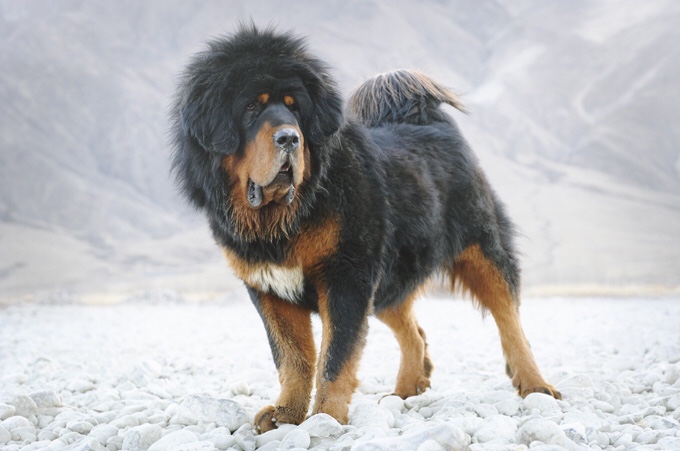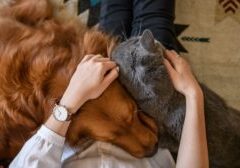
The Tibetan Mastiff is an absolutely massive Tibetan dog breed. It has its origins in the nomadic cultures of Tibet, India, Nepal and China. In fact, in the vernacular, the Tibetan Mastiff is referred to as “Drog-Khyi” which roughly translates to “that a dog that may be tied.” This fits in with what the Tibetan Mastiff is primarily used for: protection of cattle from bears, wolves, tigers, etc.
A Brief History
The Tibetan Mastiff is said to be among the oldest breeds that are still around. Marco Polo mentioned the Tibetan Mastiffs as far back as the 13th century. From the evidence that is actually available, it appears that the breed has remained virtually unchanged for an extraordinary number of years. Bones and pictures from earlier eras attest to this.
General Information
The Tibetan Mastiff is arguably the most courageous dog breed that you will set your eyes on. Independent and territorial, it is a guardian of cattle par excellence and its loyalty to its family is of the highest order. Its appearance is scarily impressive. It has a heavy coat that is both thick and long. With a heavy undercoat in cold weather and little undercoat in warmer temperatures, the Tibetan Mastiff is well equipped to handle all kinds of weather.
Below is a breakdown of the basic facts of as well as the pro’s & con’s of The Tibetan Mastiff:
Height
The Mastiff has an average height of 25 to 28 inches. They are usually slightly longer than they are tall. Males tend to be taller than females.
Weight
They can weigh anywhere between 140 pounds to 170 pounds. There are a few owners of Mastiffs who swear that their pets weigh about 200 pounds. Regardless of the veracity of their claims, the vast majority of Tibetan Mastiffs fall in the aforementioned weight range.
Litter size
The Tibetan Mastiff has a litter size of 6 to 12 puppies.
Color
Usually black, brown, blue/gray and shades of gold.
Life span
The Tibetan Mastiff typically lives from 10 years to 14 years.
Shedding
Moderate to heavy shedding.
Pros Of The Tibetan Mastiff
The pros of having a Tibetan Mastiff may be enumerated as follows:
Extremely Loyal And Protective
The Mastiff is one of the most loyal and protective dog breeds that you will set your eyes on. They will do anything to protect their family. Think a million times before messing with their families!
Aesthetic Appeal
They have a very pretty coat which comes in myriad colors. The Mastiff packs a punch when it comes to aesthetic appeal.
Imposing Figure – Great Deterrent
Its towering figure acts as an excellent deterrent. With the Mastiff next to you, you can be sure that no one will come to you looking for a fight in a hurry. The best part is, the Mastiff is not aggressive by nature.
Loves The Outdoors But Is Quiet Indoors
This is a dream combination for pet owners. Sometimes dogs which are more inclined to be outdoors have trouble staying indoors which may result in unwanted demand barking. The Tibetan Mastiff could not be more different. Whilst it is an outdoor dog in every sense of the word (rejoice all you nature fans!), it is extremely quiet indoors (as an adult).
Cons Of A Tibetan Mastiff
Requires Rigorous Training
If you want to have a fulfilling experience of owning a Tibetan Mastiff, then you have to put in the hard yards as the dog owner. Your Mastiff requires a lot of training. Given how strong-headed and independent it is, this is by no means the easiest task in the world.
Takes Up A Lot Of Space – Not Ideal For Apartments
Let us get this straight at the outset: you CAN have a Tibetan Mastiff in an apartment. However, they need to be trained very well otherwise it is just not viable. Moreover, the apartment has to be spacious as the towering figure of the Mastiff takes up a lot more space than you can imagine.
They Take Time To Socialize
Tibetan Mastiffs are somewhat introverted in that they take time to socialize. However, with quality training and constant supervision, this can be achieved.
Things To Consider Before Getting A Tibetan Mastiff
Exercise Needs
The Mastiff requires a reasonable amount of exercise. Daily walks are imperative. It is a bad idea to let it stay indoors all day. Over-exercising him is not advisable since that takes away energy that the Mastiff puppy needs to grow and gain a healthy weight.
Does Not Always Get Along With Other Animals
It can be aggressive towards other animals, particularly those of the same sex. You will have to factor this in if you already have several other animals.
Trainability
Obedience training has to take place when the Mastiff is young. Do not be too harsh on it and avoid punishments. Mutual respect and compassion go a long way with training the Tibetan Mastiff.
Guard Dog Capabilities
As mentioned earlier, the Tibetan Mastiff is an excellent guard dog.
Health Problems
The most common health problems with the Mastiff are ear infections, thyroid disorders, hip dysplasia and skin problems.
They Do Not Like To “play fetch”
The Tibetan Mastiff is not your average dog that is happy to play fetch. If a dog like that is what you are after, then the Tibetan Mastiff may not be the right choice for you.
Conclusion
All things considered, the Tibetan Mastiff is not for everyone. However, if you are keen on getting one, then there are plenty of good reasons for doing so. If possible, adopt one from an animal shelter. These typically tend to be more sociable and less aggressive.
Are you an owner of a Tibetan Mastiff? Tweet us at @FetchPetCare..



